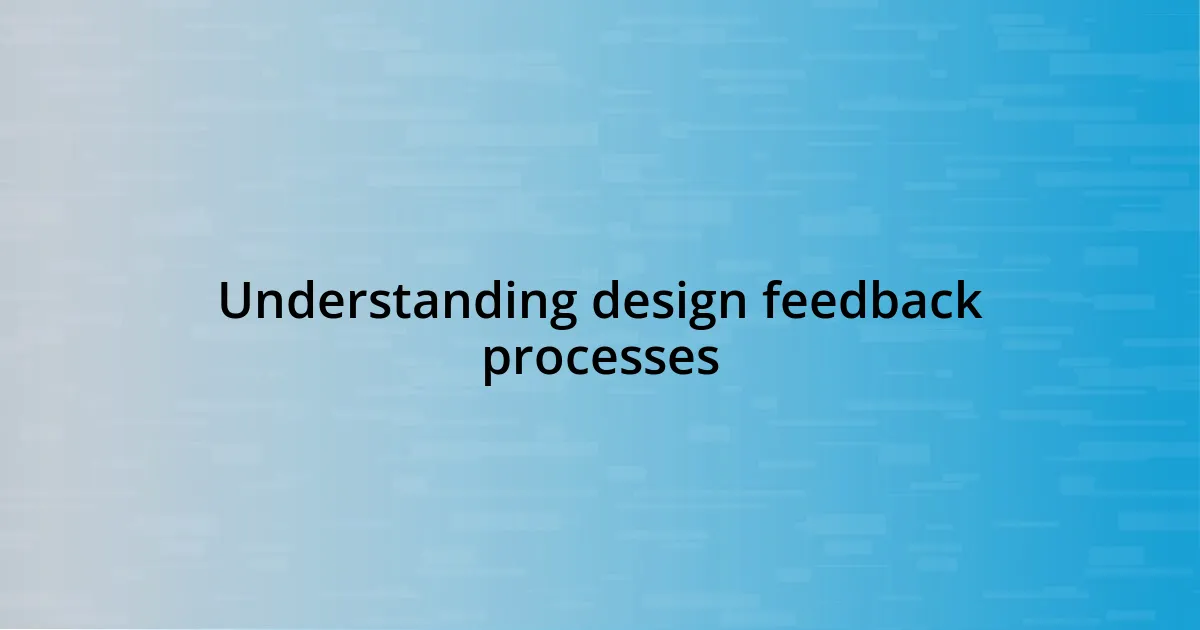Key takeaways:
- Feedback is a conversation that thrives in a safe environment, leading to valuable insights when all voices are heard.
- Preparation for feedback sessions is essential; gathering materials, creating an agenda, and mentally readying oneself fosters a productive atmosphere.
- Analyzing and prioritizing feedback through categorization and collaborative discussions helps uncover essential insights and swift actionable changes.
- Implementing changes based on feedback should include clear communication, transparency with the team, and monitoring the impact to measure success.

Understanding design feedback processes
Understanding design feedback processes begins with recognizing that feedback isn’t just criticism; it’s a conversation. In my experience, I’ve often found that the most valuable insights come when everyone feels safe to express their true opinions. Have you ever been in a meeting where the atmosphere felt stifled? It often leads to half-hearted suggestions and missed opportunities for improvement.
Another crucial aspect of the design feedback process is ensuring that all feedback is constructive and grounded in a shared goal. I remember a particular project where we failed to align on our objectives before diving into critiques. It was chaotic! Without a clear understanding of what we were trying to achieve, conversations became sidetracked, and valuable time was wasted. Setting a framework for feedback can truly transform how teams collaborate.
Lastly, I’ve learned that timing is everything in the design feedback process. Providing feedback too early can feel rushed, while waiting too long can result in lost momentum. I recall an instance when I had to approach a tight deadline. Timing my feedback carefully allowed my team to focus on actionable suggestions, leading to a successful launch. Have you considered how the timing of your feedback impacts your projects?

Preparing for feedback sessions
Preparing for feedback sessions requires careful thought and strategy. I’ve found that one effective way to get ready is to gather relevant materials beforehand, such as design prototypes or project briefs. This not only helps me articulate my ideas clearly but also encourages others to focus on specific elements rather than vague impressions. It’s like being armed with the right tools before starting a project; you wouldn’t walk into a workshop without your tools, would you?
Creating an agenda is another step I take seriously. It lays out what we’ll discuss and helps keep the session on track. In one memorable session, my team found it hard to stay focused without an agenda, resulting in scattered feedback that went in circles. Setting clear goals for each feedback session ensures that we remain directed and productive. How do you usually decide what to cover?
Finally, I find it vital to mentally prepare myself for the feedback I may receive. Embracing the idea that not all feedback will align with my vision can be tough, but it opens the door for growth. I remember an instance when a colleague gave me feedback that initially felt harsh, yet it sparked an idea that completely transformed the project. Cultivating an open mindset allows me to see feedback as a stepping stone rather than a stumbling block. Are you ready to transform your thoughts on feedback?
| Preparation Strategy | Benefits |
|---|---|
| Gather Relevant Materials | Encourages clarity and focus |
| Create an Agenda | Keeps the session on track and productive |
| Mental Preparation | Promotes openness to constructive criticism |

Gathering input from stakeholders
When it comes to gathering input from stakeholders, I emphasize the importance of establishing trust early in the conversation. In one of my projects, I facilitated a feedback session where stakeholders shared their perspectives freely, largely because they felt comfortable to do so. This openness led to insights I hadn’t anticipated, and it felt like a collective brainstorming session rather than a formal critique. It’s incredible what can happen when everyone feels their input is valued.
To ensure a collaborative atmosphere, I always encourage a diverse range of opinions. Here’s how I approach this:
- Create an Environment of Respect: I remind everyone that each perspective is valid, regardless of their role.
- Use Open-Ended Questions: I often ask questions that can’t be answered with a simple yes or no. This approach sparks deeper discussions.
- Acknowledge Contributions: I make it a point to highlight valuable insights during the meeting, which helps build confidence and encourages more input.
In one particularly engaging session, I noticed that when I stood back and let quieter team members share, the most innovative ideas emerged! It was a humbling reminder that everyone’s voice matters and can lead to extraordinary breakthroughs. How do you create a safe space for authentic feedback?

Analyzing and prioritizing feedback
Analyzing feedback effectively is crucial to ensuring that the insights gathered are truly meaningful. I start by categorizing the feedback into themes, distinguishing between technical suggestions and aesthetic preferences. During one feedback session, I found myself overwhelmed by a flurry of comments. By pinpointing recurring themes, such as usability concerns or design clarity, I gained clarity and directed my focus where it was needed most. How do you sift through the noise to find the essential insights?
Once I’ve organized the feedback, prioritizing it is the next logical step. I often use a simple matrix to rate each piece of feedback based on impact and effort required to implement the changes. This method not only streamlines my decision-making process but also helps me identify quick wins—those small adjustments that can have a significant positive effect. I recall a time when prioritizing helped me spot a seemingly minor color adjustment that turned a confusing layout into something intuitive and engaging. It made me realize the power of even the smallest changes.
Engaging with my team during this process is also a game-changer. I sometimes hold a quick huddle, allowing everyone to voice their opinion on which pieces of feedback resonate most. This collaborative approach ensures that I’m not operating in a vacuum, and it often surfaces different perspectives I might have missed. It’s a reminder that the best design decisions come not just from analysis but from the synergy of collective experiences. Have you ever included your team in this phase, and if so, what surprising insights did they bring to the table?

Communicating effectively with teams
Effective communication within teams is essential for fostering a culture of collaboration. I’ve found that using a shared digital platform helps everyone stay on the same page. For instance, during one project, I set up a dedicated Slack channel where team members could share their thoughts and updates in real time. Watching the conversations unfold was like witnessing a vibrant brainstorming session—ideas flowed freely, and we could address concerns while they were still fresh.
Listening actively is just as important as speaking. I recall a time when a team member brought up their hesitations about a project direction. By genuinely listening, I realized that their concerns stemmed from a lack of clarity, which I had unintentionally overlooked. This moment taught me that asking for feedback doesn’t just mean waiting for it; it involves tuning in and validating each team member’s feelings. Have you ever experienced a moment where simply listening transformed a situation for the better?
I also prioritize regular check-ins, whether through informal one-on-ones or group meetings. This helps prevent misunderstandings and keeps everyone aligned. Once, during a routine check-in, a member voiced their struggle with task overload. By addressing this openly, we collaborated as a team to redistribute responsibilities, which not only alleviated their stress but also strengthened our bond. It’s fascinating how proactive communication can turn potential frustrations into opportunities for growth and teamwork. What steps do you take to ensure everyone feels heard and supported?

Implementing changes based on feedback
Implementing changes based on feedback can sometimes feel daunting, but I approach it with a clear mindset. After carefully sifting through the feedback, I often find it helpful to create a simple action plan outlining which suggestions will be implemented, along with the reasons behind each choice. For instance, I once received a range of mixed feedback about a specific design element. Instead of feeling overwhelmed, I broke it down into actionable steps and presented my reasoning to the team. This transparency not only built trust but also energized everyone involved.
When it comes to executing the changes, I ensure that I keep the lines of communication open with my team. I recall a project where I was tasked with modifying a user interface based on feedback that suggested improving accessibility. As I began implementing changes, I regularly checked in with the team for their insights on each adjustment, which helped create a sense of shared ownership. It’s incredible how feedback can lead to collaboration; have you ever seen a design evolve through a team’s collective input?
Moreover, I make a point to track the impact of these changes post-implementation so I can assess whether they’ve truly addressed the issues raised in the feedback. For example, after revising a navigation flow based on user insights, I monitored user interaction metrics for a few weeks. The improvements were evident, and I was thrilled to share that success with the team. It’s these tangible results that reinforce the value of feedback; how do you measure the success of changes made in your design process?

Evaluating feedback impact on designs
Evaluating the impact of feedback on designs is a crucial part of my creative process. I remember during one project, we received feedback that highlighted usability issues. Instead of viewing it as a setback, I dove deep into the suggestions, considering how each one could enhance user experience. This reflection not only refined the design but also re-energized my passion for creating something truly user-centered. Isn’t it fascinating how constructive criticism can breathe new life into a project?
As I evaluate feedback, I often rely on metrics to quantify changes. In a past scenario, we were informed that users found the interactive elements confusing. By tracking user behavior analytics before and after the redesign, I discovered significant improvements in engagement. Witnessing these numbers shift was not just gratifying—it affirmed that user input was genuinely shaping a better product. How do you usually analyze feedback effectiveness in your designs?
Ultimately, assessing the feedback’s impact requires an openness to adapt and evolve. In a particularly challenging instance, I faced conflicting opinions about a color palette choice. After taking time to evaluate the emotions tied to the feedback, I realized that ensuring emotional resonance with users was more vital than adhering strictly to personal preference. By embracing this realization, we adjusted our approach, leading to a design that truly connected with its audience. What insights do you gather from feedback that surprise you the most?














